Exocrine pancreatic insufficiency (EPI) is a condition characterized by deficiency of the exocrine pancreatic enzymes, resulting in the inability to digest food properly, or maldigestion Who gets EPI?The pancreatic duct is a tube that collects the digestive juices made by the pancreas and carries them into the first part of the bowel (duodenum) What the pancreas does The pancreas makes digestive juices, as well as different types of hormones such as insulin The part of the pancreas that makes digestive juices is the exocrine pancreas The endocrine pancreatic tissue consists of small, discrete clusters of cells, called islets of Langerhans (also called pancreatic islets), scattered throughout the exocrine pancreatic lobules Unlike the exocrine pancreatic acini, which secrete into a ductular system, cells of the islets of Langerhans secrete directly into small fenestrated capillaries that are integrated within
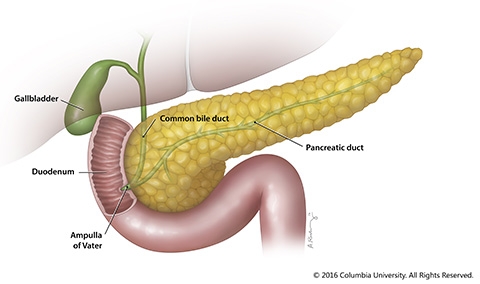
The Pancreas And Its Functions Columbia University Department Of Surgery
Exocrine pancreas vs endocrine pancreas
Exocrine pancreas vs endocrine pancreas- The pancreas has two components Exocrine pancreas produces enzymes that break down food in the small intestine; Dr Cynthia Rudert, Celiac Disease and Gluten Intolerance expert answers your questions on celiac 5 million emergency room visits in the US are for diarrhea and abdominal pain If you have chronic symptoms, could it be EPI?
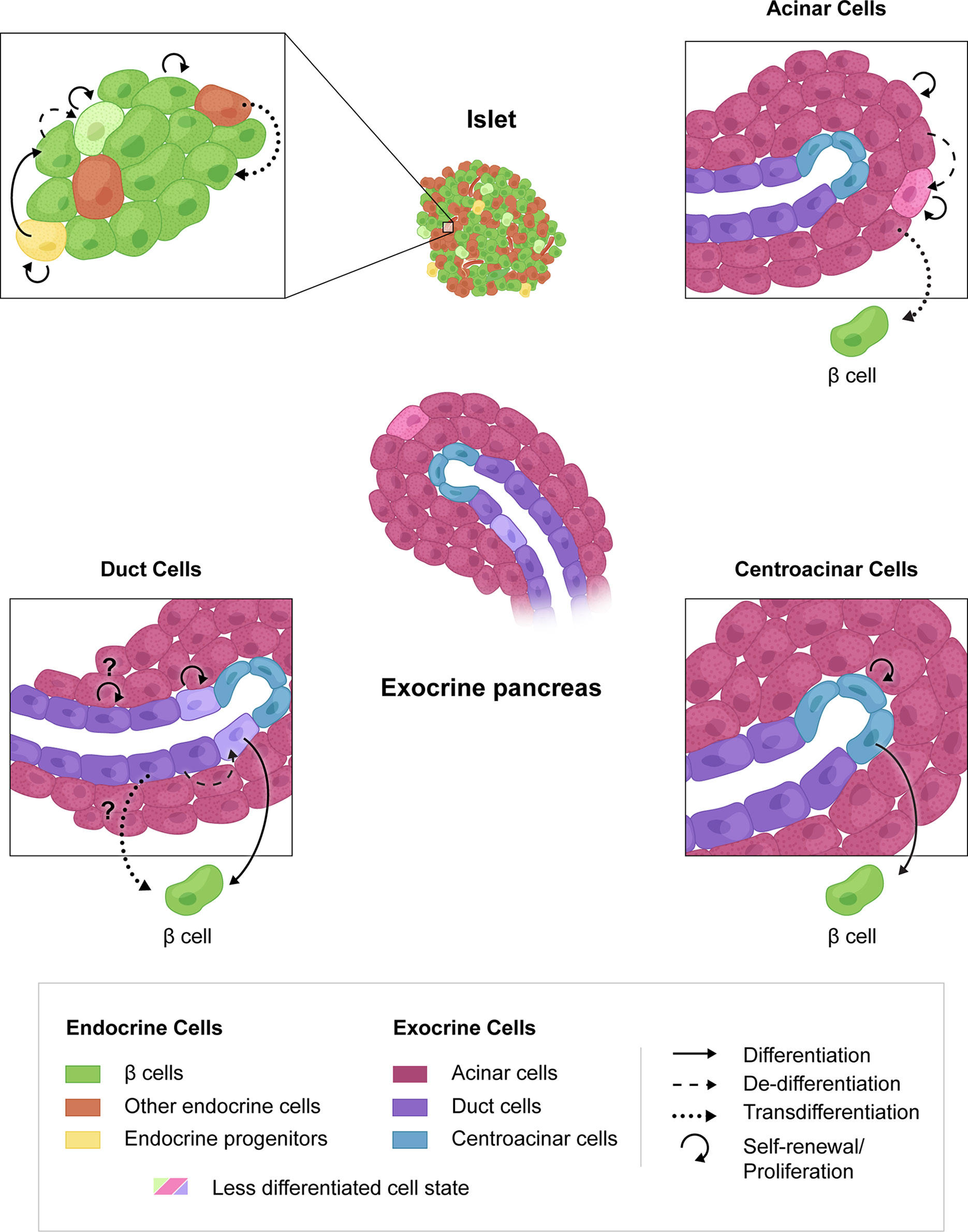



Frontiers Debates In Pancreatic Beta Cell Biology Proliferation Versus Progenitor Differentiation And Transdifferentiation In Restoring B Cell Mass Endocrinology
99% part of pancreas is exocrine and 1% part is endocrine As an endocrine gland, it functions mostly to regulate blood sugar levels, secreting the hormones insulin, glucagon, somatostatin, and pancreatic polypeptide As a part of the digestive system, it functions as an exocrine gland secreting pancreatic juice into the duodenum through the pancreatic duct The pancreas is both an endocrine and exocrine gland because it secretes both hormones and digestive enzymes The pancreas the the main regulator of blood glucose levels It produces insulin which decreases blood glucose levels and glucagon which increases blood glucose levels This is the exocrine function A decline in pancreatic tissue occurs because of the constant inflammation, and this results in an exocrine and endocrine insufficiency Exocrine and endocrine insufficiency lead to maldigestion and intolerance of certain kinds of food (mainly fats) with nausea, vomiting, meteorism, weight loss, and diabetes mellitus In earlier stages, these consequences can be
There was no statistically significant difference in ExoPI found between pancreaticogastrostomy (PG) and pancreaticojejunostomy (PJ) (100% vs 98%;Pancreatic endocrine and exocrine insufficiencies in chronic pancreatitis evolve with different time dependencies, and in most cases, exocrine insufficiency precedes endocrine insufficiency by many years (Layer et al, 1994) Exocrine insufficiency is more closely correlated with morphologic changes (ie, fibrosis, calcifications) than is endocrine insufficiency The pancreas is a twoheaded organ, not only in origin but also in function In origin, the pancreas develops from two separate primordia In function, the organ has both endocrine function in relation to regulating blood glucose (and also other hormone secretions) and gastrointestinal function as an exocrine (digestive) organ, see exocrine pancreas
Endocrine pancreas produces hormones that regulate blood sugar;Pancreatic Histology Exocrine Tissue The pancreas is surrounded by a very thin connective tissue capsule that invaginates into the gland to form septae, which serve as scaffolding for large blood vessels Further, these septae divide the pancreas into distinctive lobules, as can clearly be seen in the image of mouse pancreas below (H&E)Created by Raja NarayanWatch the next lesson https//wwwkhanacademyorg/testprep/nclexrn/rngastrointestinalsystem/rnthegastrointestinalsystem/v/end




Endocrine Pancreas And Diabetes Mellitus Dr Heyam Awad



Exocrine Pancreas
The exocrine part produces about 15 l of pancreatic juice every day The endocrine part, which accounts for ~1% of the pancreas, consists of the cells of the islands of Langerhans These cells produce insulin, glucagon and a number of other hormones The exocrine pancreas consists of tubuloacinar glandsThe Endocrine Pancreas Introduction and Index The pancreas houses two distinctly different tissues The bulk of its mass is exocrine tissue and associated ducts, which produce an alkaline fluid loaded with digestive enzymes which is delivered to the small intestine to facilitate digestion of foodstuffsScattered throughout the exocrine tissue are several hundred thousand clusters of My daughter was born without a Pancreas, so we have both no Endocrine Function and no Exocrine Function Basically the exocrine function of the pancreas is alot of hormones and digestive enzymes the hormones themselves are also produced by other organs so not an issue, however the lack of Digestive Enzymes is a very big issue




Rest Inhibits Direct Reprogramming Of Pancreatic Exocrine To Endocrine Cells By Preventing Pdx1 Mediated Activation Of Endocrine Genes Sciencedirect



Functional Anatomy Of The Endocrine Pancreas
Cancer can start in the head, body or tail of the pancreas The wide end of the pancreas is called the head The thin end is called the tail The bit in the middle is called the body Between 60 and 70 out of 100 pancreatic cancers (6070%) start in the head of the pancreas Exocrine pancreatic cancers Most pancreatic cancers are the exocrineEndocrine pancreas Current time so special physiologically the pancreas releases two types of things or has two main components to it one there's the exocrine pancreas and the idea behind the exocrine pancreas is that it takes salts and write it down here enzymes so these powerful enzymes I talked about earlier it takes these salts andP=1000) Remnant pancreatic volume less than 395% was predictive of ExoPI Conclusion ExoPI occurs quasisystematically after PD irrespective of the reconstruction scheme The rate of EndoPI did not differ between PD and LP




The Pancreas And Its Functions Columbia University Department Of Surgery




Vip Reduction In The Pancreas Of F508del Homozygous Cf Mice And Early Signs Of Cystic Fibrosis Related Diabetes Cfrd Journal Of Cystic Fibrosis
The pancreas and liver are both endocrine AND exocrine organs As an endocrine organ, the pancreas secretes the hormones insulin and glucagon As an exocrine organ, it secretes several enzymes that are essential for digestion in the small intestine The liver secretes insulinlike growth factors in response to stimulation by growth hormone Exocrine pancreatic insufficiency (EPI) is defined by a deficiency of exocrine pancreatic enzymes resulting in an inability to maintain normal digestion This inadequate digestion with nutrient and, especially, fat malabsorption occurs when intraduodenal levels of lipase fall below 5–10% of normal enzyme output 1 , leading to pancreaticExocrine pancreas Endocrine pancreas This is the currently selected item all right and then on that note why don't we move on to the next part of the pancreas which is known as the endocrine pancreas and this is actually the part of the pancreas that is the most famous we hear the most about this as we'll see in a minute because it has a
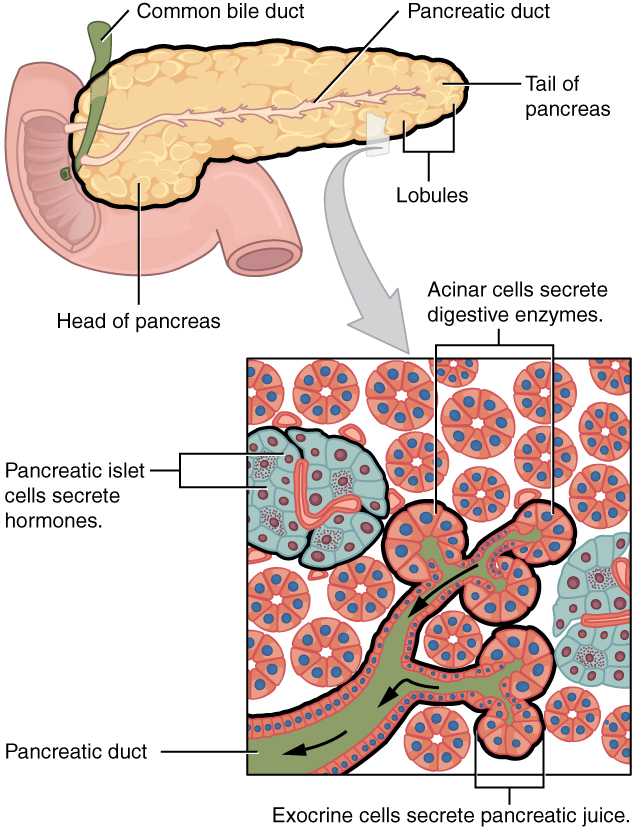



Pancreas Endocrine And Exocrine Functions Medical Library




Exocrine Pancreas Definition Of Exocrine Pancreas By Medical Dictionary
Exocrine pancreas is related to secretion of digestive enzymes that are secreted from secretory acini and transported to GIT through duct system Main duct of this system is the pancreatic ductThe acinar secretions of the exocrine pancreas are collected by the pancreatic ducts The ducts are surrounded by a small amount of connective tissue without inflammation or fibrosis (scarring)The endocrine pancreas resides in the islets which are regularly arranged and present within the pancreatic lobules 11Exocrine pancreatic insufficiency (EPI) causes problems in how you digest food Your pancreas doesn't make enough of the enzymes that your body needs to break down and absorb nutrients




Sex Differences In The Exocrine Pancreas And Associated Diseases Cellular And Molecular Gastroenterology And Hepatology
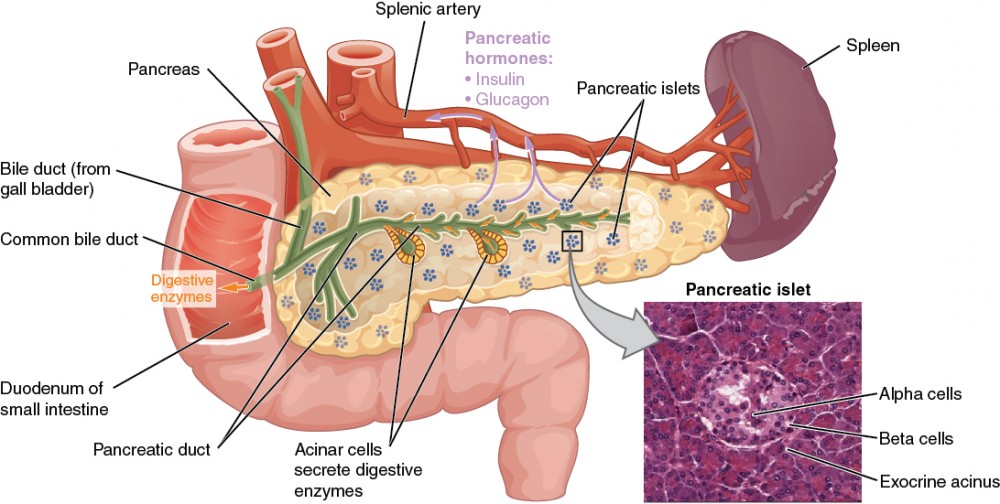



The Endocrine Pancreas Anatomy And Physiology Ii
5 VHL and the pancreas VHL increases risk of several types of pancreatic masses and cysts Mass is solid Cyst is fluid filled Most will be benign One type of mass seen is a pancreatic neuroendocrine tumor Pancreatic Neuroendocrine Tumors (PNETs) 1015% of all PNETs are associated with genetic syndromesAbout threequarters of exocrine pancreatic cancer arises in the head and neck of the pancreas (the anatomic parts through which the pancreatic duct runs just before it meets the duodenum) Some of these carcinomas arise in the body of the pancreatic organ, and less than ten percent arise in the tail of the pancreas (the tapering smallerPancreatic Exocrine Tumors About 94% of pancreatic cancers are classified as exocrine tumors These tumors start in the exocrine cells of the pancreas The following table describes the most common pancreatic exocrine tumors Adenocarcinoma is the most common type of pancreatic cancer It accounts for about 90% of all pancreatic cancers




Regeneration Of The Exocrine Pancreas The Exocrine Pancreas Is Download Scientific Diagram
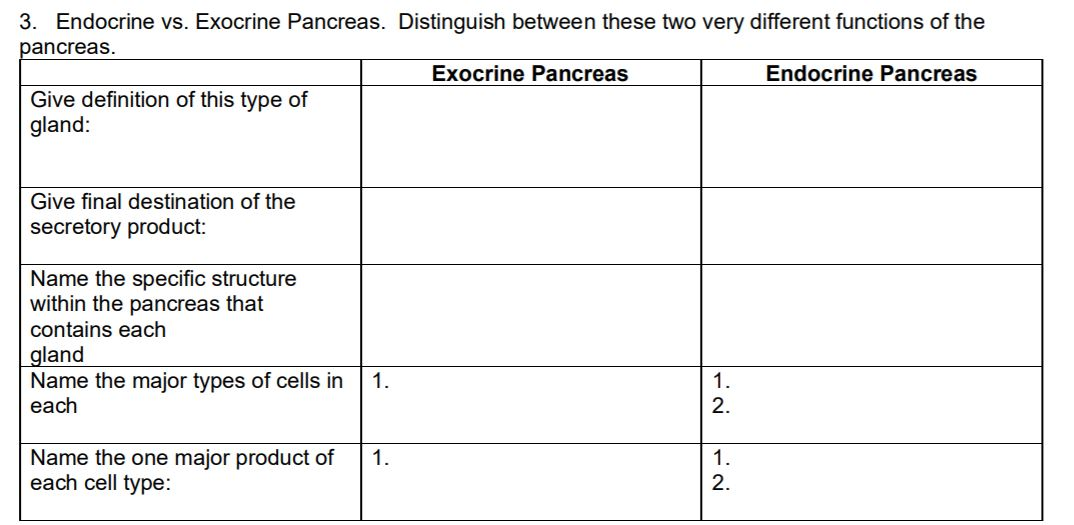



Solved 3 Endocrine Vs Exocrine Pancreas Distinguish Chegg Com
Pancreatic endocrine tumors have different symptoms, act differently and respond to different treatments than the more common pancreatic exocrine tumors PNETs are classified by the hormones they make6 Imaging tests are important in diagnosing pancreatic cancer All rights reserved Perhaps the earliest demonstration of direct endocrinologic intervention inDr Rudert answers questions on this often misdiagnosed disorder What are the symptoms of EPI (Exocrine Pancreatic Insufficiency)?




Tissue Engineering And 3d Printing Of Bioartificial Pancreas For Regenerative Medicine In Diabetes Trends In Endocrinology Metabolism




Endocrine Vs Exocrine Glands Youtube
An essential pancreatic function is the conversion of food into fuel for the body's cells The exocrine part produces mainly digestive enzymes and helps in digestion, whereas the endocrine part is responsible for the regulation of carbohydrate metabolism (ie bloodList eight forms of endocrine and eight exocrine pancreatic cancers, identify their key features and how the TNM method of staging is used to grade them ENDOCRINE 1) Gastrinoma (ZES) 2) Glucagonoma usually large, often mets, 70% malignant 3) Insulinoma most common pancreaticThe exocrine pancreas is a grapelike clustering of acinar glands drained by ductules that ultimately converge to form the pancreatic duct Through this duct, pancreatic secretions enter the proximal duodenum Interspersed among the pancreatic acini are islets of Langerhans, or the endocrine pancreas, which produces insulin, glucagon, and somatostatin
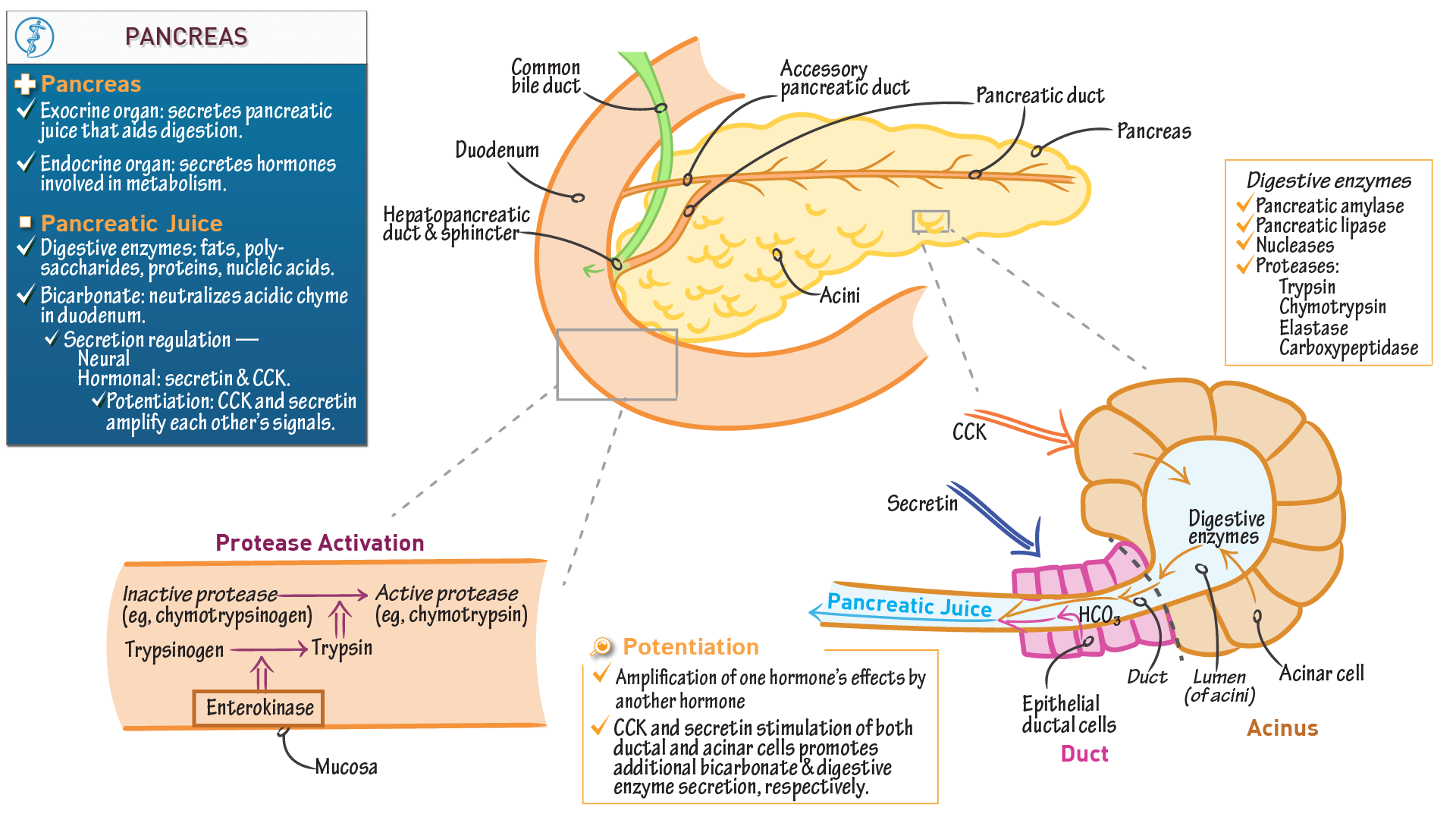



Exocrine Pancreas Draw It To Know It



Acinar Cells
4 rows The pancreas is both an exocrine accessory digestive organ and a hormone secreting endocrineThe pancreas is the only gland that is both an endocrine and exocrine It is an exocrine gland in the sense that it has a duct that stores pancreatic juices which will then be secreted by the pancreas for future useExocrine pancreatic cancer develops from exocrine cells, which make up the exocrine gland and ducts of the pancreas The exocrine gland secretes enzymes that help break down carbohydrates, fats, proteins and acids in the duodenum The various types of exocrine pancreatic cancers make up more than 95 percent of all cancers of the pancreas
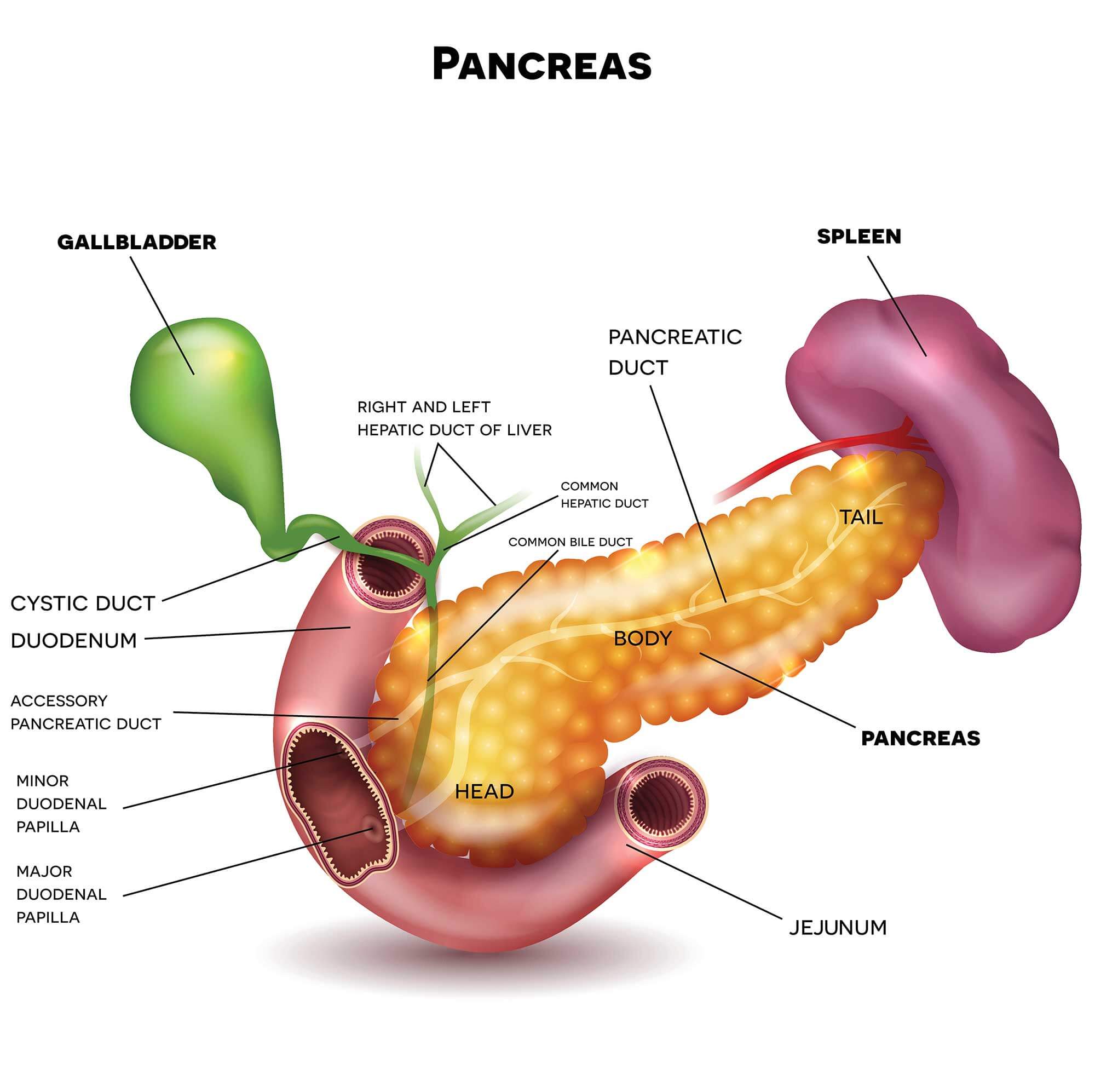



Pancreatic Cancer Types Johns Hopkins Medicine




Exocrine Pancreatic Insufficiency In Dogs Vca Animal Hospital
Morbidity of endocrine and exocrine pancreatic insufficiency Thirty four of 113 patients (301%) was diagnosed with DM, 33 patients (292%) with IGT and 46 patients (407%) with normal endocrine function as shown in Fig 1The incidence of abdominal pain, abdominal distension and diarrhea (including fat diarrhea) was respectively 53%, 106% and 1504%The Exocrine Pancreas in Dogs and Cats The pancreas has both endocrine and exocrine functions The exocrine pancreas is made up of pancreatic acinar cells and a duct system that opens into the proximal duodenum Pancreatic acinar cells synthesize and secrete digestive enzymes (eg, amylase, lipase, and others) and inactive proenzymes ofEndocrine cells of the pancreas The endocrine pancreas consists of endocrine cells that are arranged in "islets" and release hormones into the bloodstream
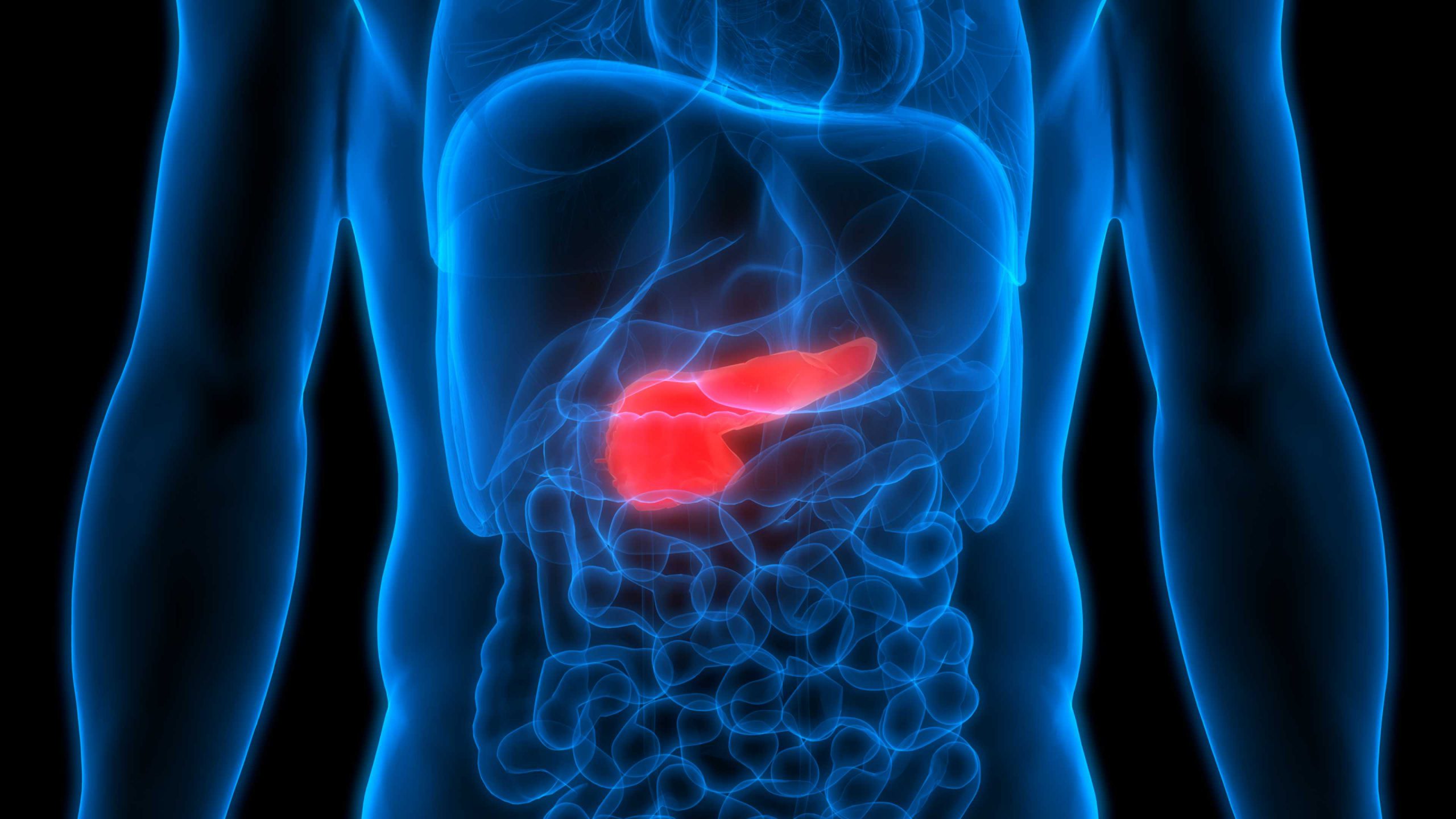



Exocrine Pancreatic Insufficiency Causes Diagnosis Treatment
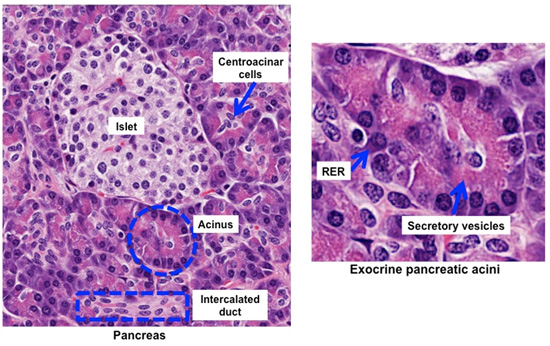



Human Structure Virtual Microscopy
Exocrine = pancreatic juice (digestive enzymes electrolytes Endocrine = hormones (namely insulin and glucagon) The main pancreatic duct joins the common bile duct to drain iEPI is associated with certain diseases and conditions that affect the pancreas Some of these diseases you are born with, like cystic fibrosis, while others may occur Read MoreContext A major role of the pancreas in zinc homeostasis has been suggested Objective To assess erythrocyte zinc status in chronic pancreatitis and to correlate it with pancreatic exocrine and endocrine insufficiency Patients One hundred and one patients with chronic pancreatitis (34 alcoholic chronic pancreatitis, 67 tropical chronic pancreatitis) were prospectively studied




Pancreas Exocrine Pancreas Racemose Endocrine Pancreas Islets Of Langerhans Ppt Download




The Endocrine Pancreas Anatomy And Physiology Ii
The key difference between endocrine and exocrine systems is that the endocrine system releases produced substances directly into the blood while exocrine system does not release its products directly into the blood Exocrine and Endocrine Function of Pancreas Some glands are both exocrine and endocrine in nature The pancreas is a classic example of such a gland The pancreas releases important hormones
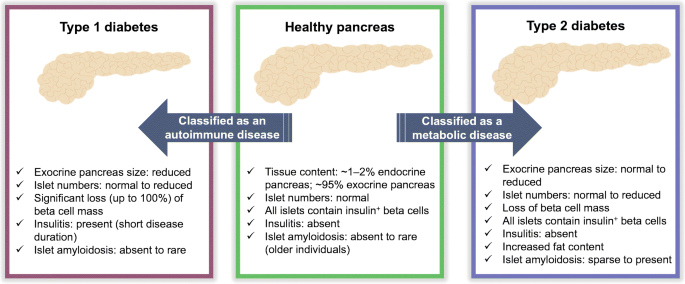



Organisation Of The Human Pancreas In Health And In Diabetes Springerlink
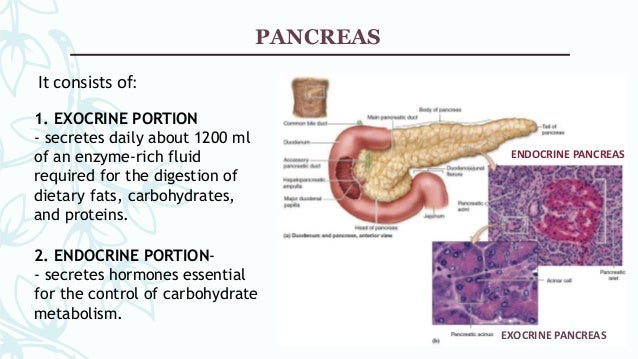



Histology Gallbladder And Pancreas




Illustrates The Location Of Endocrine And Exocrine Pancreas In The Download Scientific Diagram




Screen 2 On Flowvella Endocrine Exocrine Pancreas Png Image Transparent Png Free Download On Seekpng




Types Of Pancreatic Cancer Cancer Research Uk




What Is Pancreatic Cancer Navigate Pancreatic Cancer
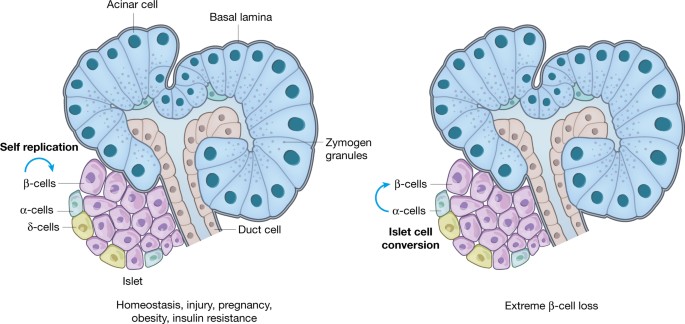



Pancreas Regeneration Nature



What Is The Function Of The Pancreas In Both Endocrine And Exocrine Systems Quora
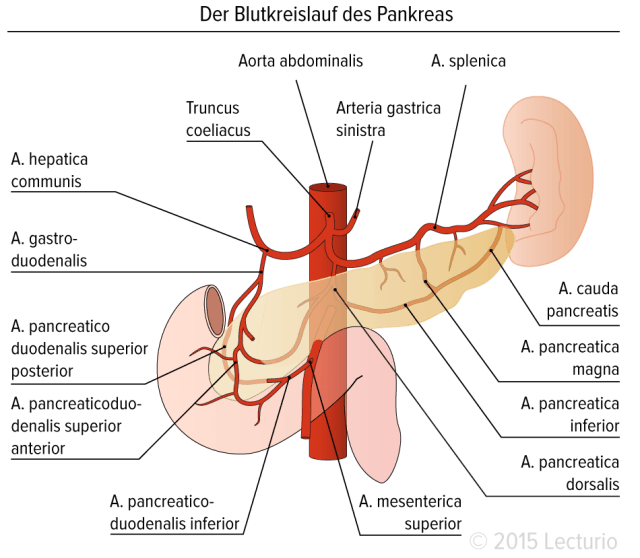



Pancreas Endocrine And Exocrine Functions Medical Library




Endocrine Pancreas Ppt Structure And Function Of The Pancreas The Pancreas Lies Inferior To The Stomach In A Bend Of The Duodenum It Is Both An Course Hero
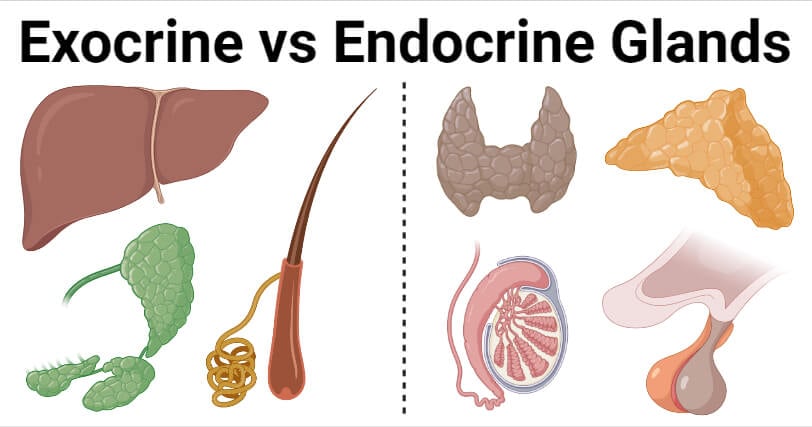



Exocrine Vs Endocrine Glands Definition 8 Differences Examples




The Endocrine And Exocrine Pancreas Cross Section Human P Flickr



E Pancreas Hook Ap Psychology 1b




Beneficial Effects Of Physical Exercise On The Exocrine Pancreas Semantic Scholar



Diabetes India Endocrine Cells In The Pancreas




A Tale Of Two Pancreases Exocrine Pathology And Endocrine Dysfunction Springerlink
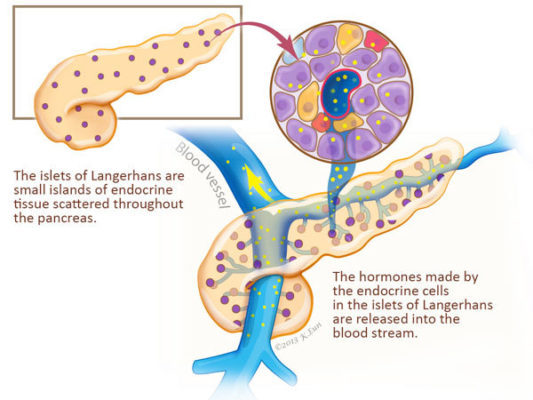



Pancreas Function Pancreatic Cancer Johns Hopkins Pathology




Implications Of Integrated Pancreatic Microcirculation Crosstalk Between Endocrine And Exocrine Compartments Diabetes




A Tale Of Two Pancreases Exocrine Pathology And Endocrine Dysfunction Abstract Europe Pmc
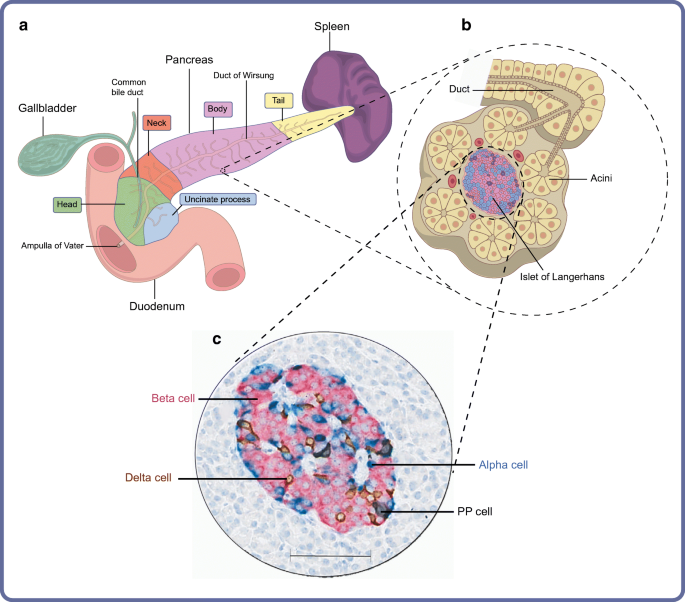



Organisation Of The Human Pancreas In Health And In Diabetes Springerlink



1
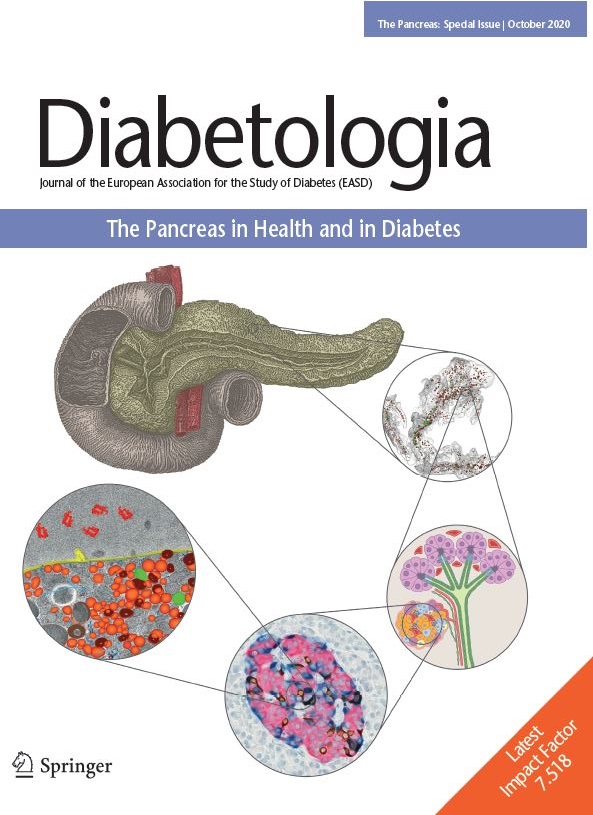



The Pancreas In Health And In Diabetes Diabetologia




What Is Epi Exocrine Pancreatic Insufficiency




Pancreas Blood Sugar Regulation Pancreas Has Both Exocrine And Endocrine Functions Endocrine Secretes Insulin And Glucagon Into The Blood To Control Ppt Download
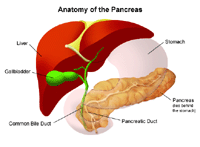



The Pancreas Johns Hopkins Medicine




Exocrine Endocrine Pancreas Stock Illustration




Endocrine System Part 2 Keri Muma Bio 6 Pancreas Located Behind The Stomach Has Both Exocrine And Endocrine Functions Ppt Download




Pancreas Histology Osmosis




Pancreatic Neuroendocrine Cancer Vs Pancreatic Cancer Netrf




Pancreas Wikipedia
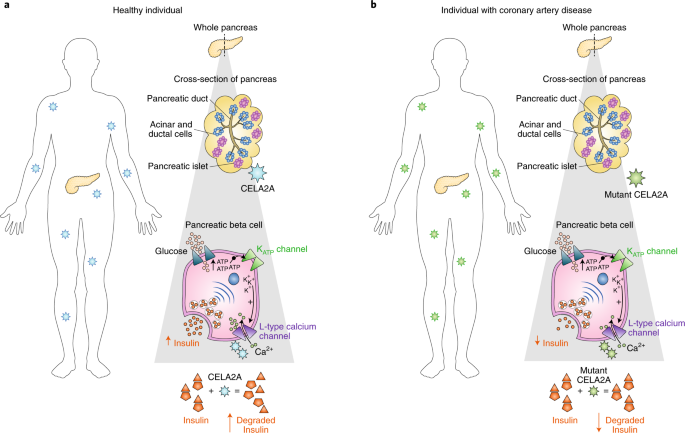



Exocrine Or Endocrine A Circulating Pancreatic Elastase That Regulates Glucose Homeostasis Nature Metabolism




An Overview Of The Pancreas Understanding Insulin And Diabetes
:watermark(/images/watermark_5000_10percent.png,0,0,0):watermark(/images/logo_url.png,-10,-10,0):format(jpeg)/images/overview_image/1881/CPsIC67xuz6pLt6JhAM6Wg_pancreas-histology_english.jpg)



Pancreas Histology Exocrine Endocrine Parts Function Kenhub




Pancreas Function Pancreatic Cancer Johns Hopkins Pathology




Pancreatic Islets Wikipedia




Figure 2 From Organogenesis Pancreatic Organogenesis Developmental Mechanisms And Implications For Therapy Semantic Scholar



1




Pancreas The Pancreas Performs Both Exocrine And Endocrine Activities A An Illustration Shows The Relationship Between The Pa Pancreas Beta Cell Pancreatic



Liver And Pancreas




Schematic Diagram Of The Vascular Arrangement In The Endocrine And Download Scientific Diagram




Pancreas Function Pancreatic Cancer Johns Hopkins Pathology




Implications Of Integrated Pancreatic Microcirculation Crosstalk Between Endocrine And Exocrine Compartments Diabetes




Anatomy And Histology Of The Pancreas Pancreapedia




Pancreas Wikipedia




Frontiers Debates In Pancreatic Beta Cell Biology Proliferation Versus Progenitor Differentiation And Transdifferentiation In Restoring B Cell Mass Endocrinology




Pancreas Endocrine Tumors Insulin Glucagon Diabetes And Others A Guide To Insulin Glucagon Somatostatin And Gastrin



Endocrine Pancreas




Pancreas Endocrine And Exocrine Pancreas Overview Youtube




Functiondysfunction Of Endocrine Pancreas Pancreas Anatomy Both Exocrine




Chronic Pancreatitis Prezentaciya Onlajn



Diabetes As A Disease Biocrine




A Primer On Exocrine Pancreatic Insufficiency Fat Malabsorption And Fatty Acid Abnormalities




Illustrates The Location Of Endocrine And Exocrine Pancreas In The Download Scientific Diagram




Question Video Describing The Function Of Pancreatic Exocrine Cells Nagwa




Diabetes Of The Exocrine Pancreas Wynne 19 Journal Of Gastroenterology And Hepatology Wiley Online Library




Pancreatic Exocrine Cancer Gut And Gastroenterology




Human Endocrine System Pancreas Definition Examples Diagrams




Endocrine Exocrine Signaling Drives Obesity Associated Pancreatic Ductal Adenocarcinoma Sciencedirect



What Are Some Relevant Examples That Explain Why The Pancreas Gland Has Both The Exocrine And Endocrine Function Quora




Human Pancreatic Exocrine Response To Nutrients In Health And Disease Gut




Anatomy And Histology Of The Pancreas Pancreapedia
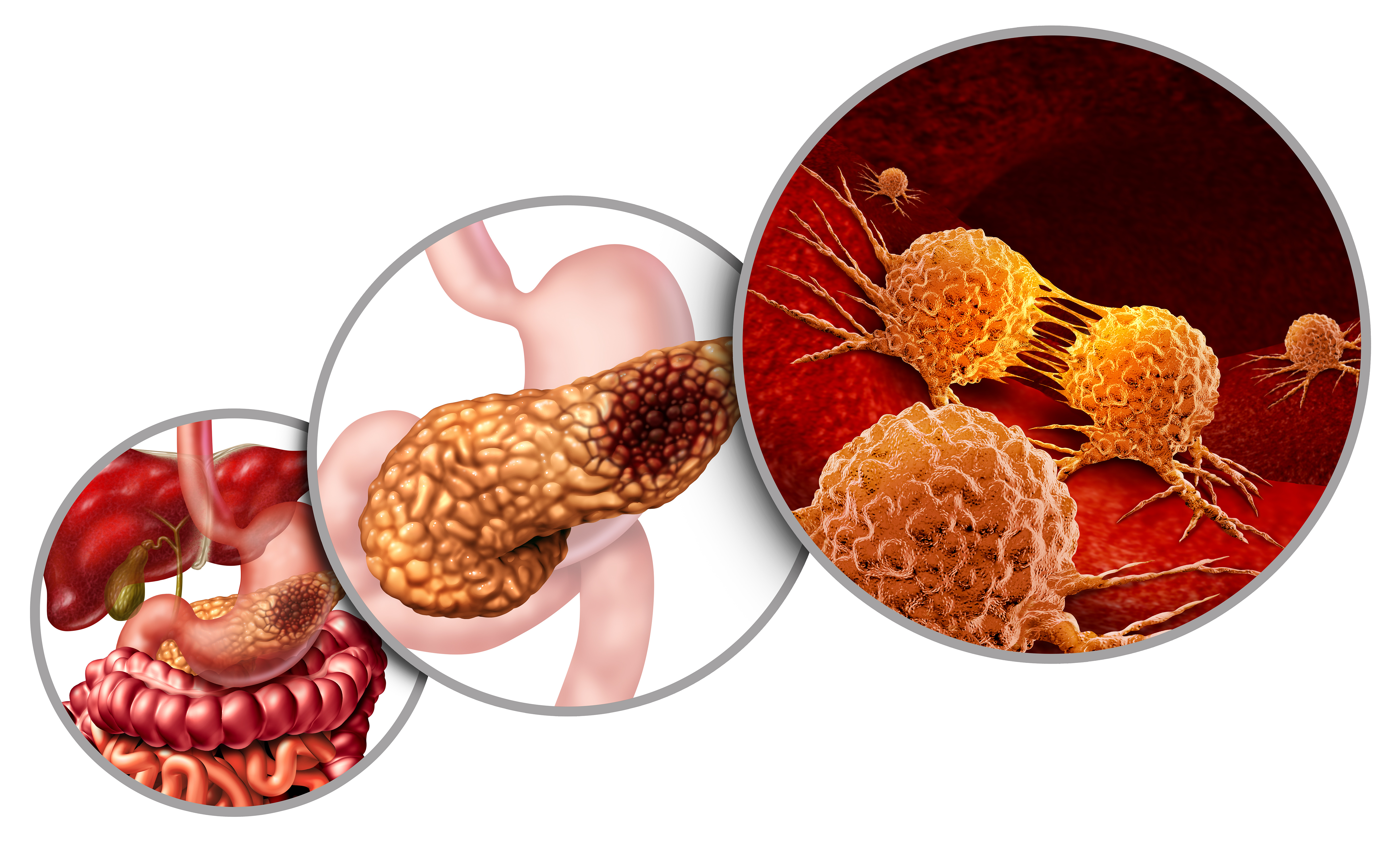



Pancreatic Cancer Stages And Outcomes




Exocrine Pancreas Flashcards Quizlet




Pancreas Exocrine And Endocrine Function Youtube



Histology Home Page
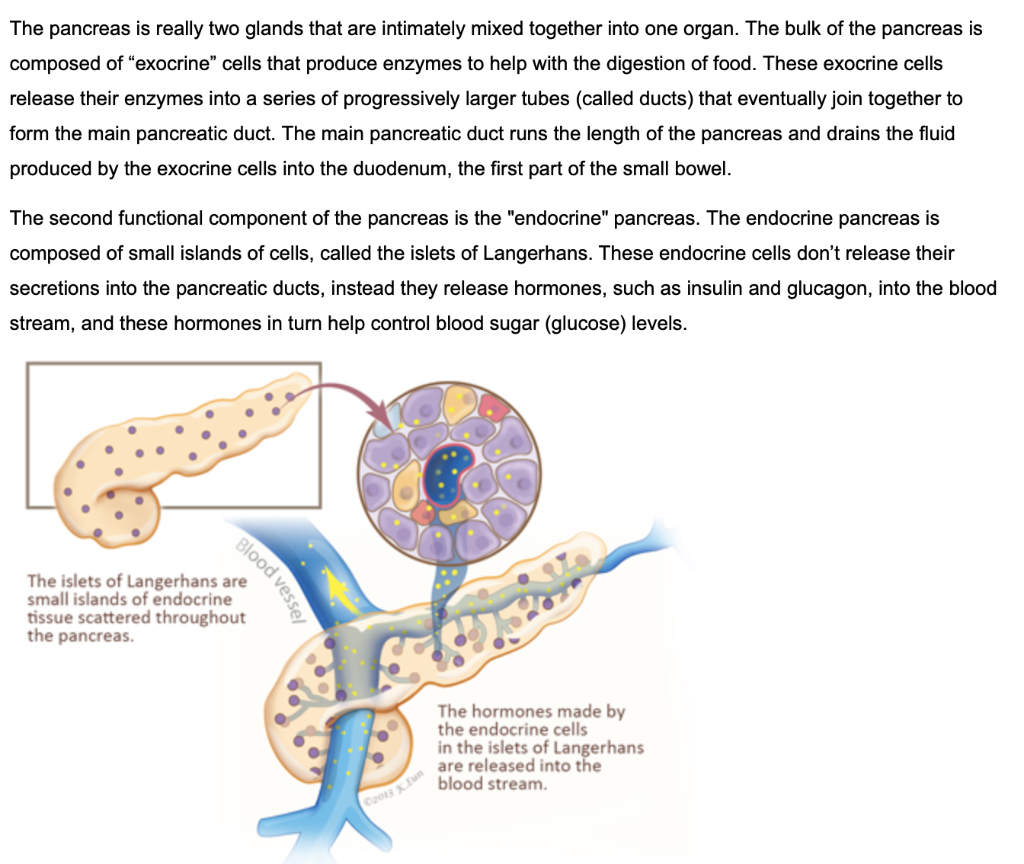



Solved Prompt The Pancreas Has Both Endocrine And Exocrine Chegg Com




P2ry1 Alk3 Expressing Cells Within The Adult Human Exocrine Pancreas Are Bmp 7 Expandable And Exhibit Progenitor Like Characteristics Cell Reports




Endocrine Pancreas Endocrine Medbullets Step 1




Implications Of Integrated Pancreatic Microcirculation Crosstalk Between Endocrine And Exocrine Compartments Diabetes




Pin On Biology Drawing Neet




Pancreas Functions And Disorders




The Pancreas And Its Functions Columbia University Department Of Surgery




Endocrine Pancreatic Cell Types And Their Peptide Secretions Exocrine Download Scientific Diagram




Pin On Bsf




Exocrine And Endocrine Parts Of The Pancreas Doccheck



Endocrine Pancreas Physiology Flashcards Draw It To Know It




Human Pancreatic Afferent And Efferent Nerves Mapping And 3 D Illustration Of Exocrine Endocrine And Adipose Innervation American Journal Of Physiology Gastrointestinal And Liver Physiology



Ha 235 Histology Accessory Digestive Glands
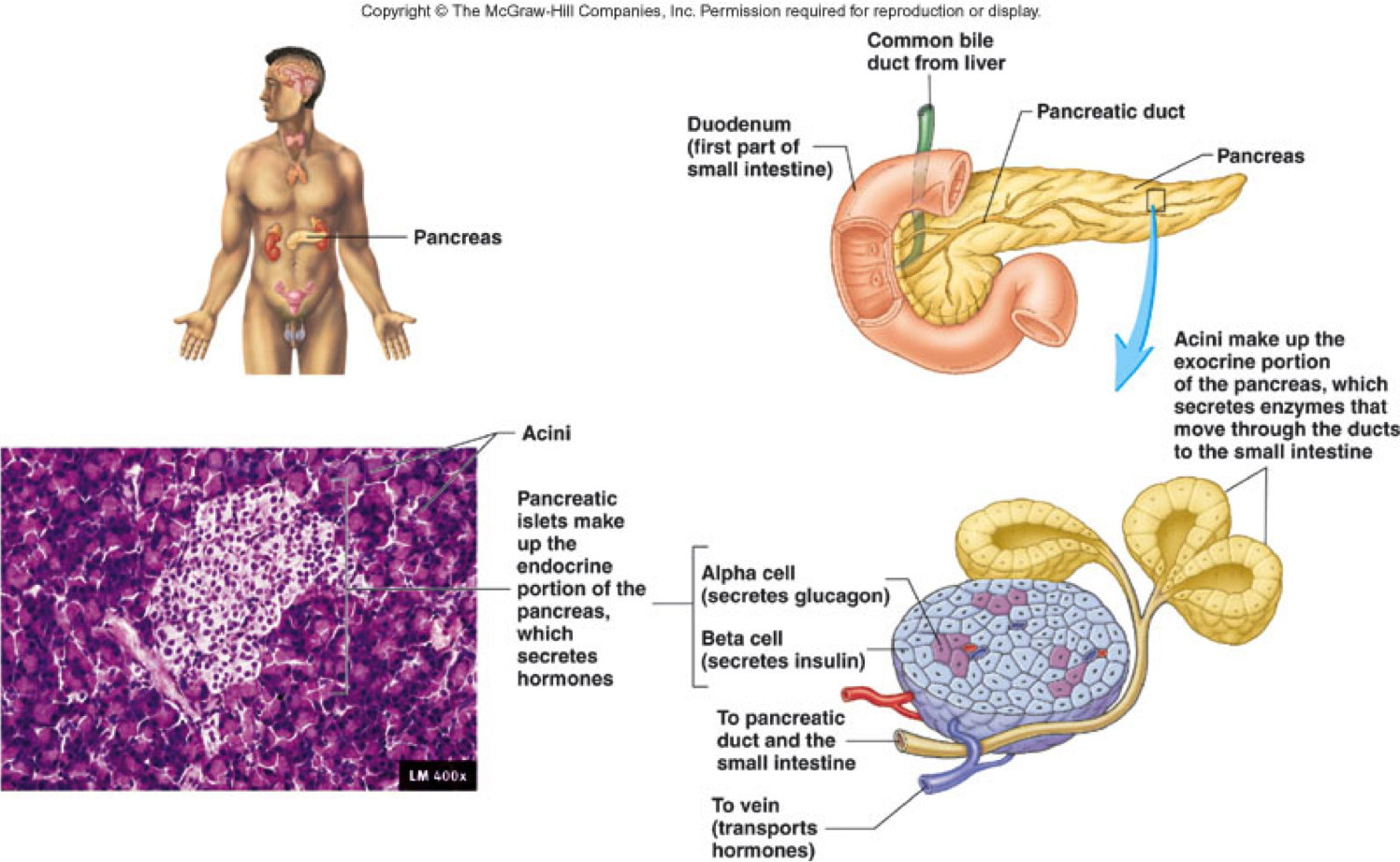



Do Any Of The Exocrine Glands Produce Hormones Socratic
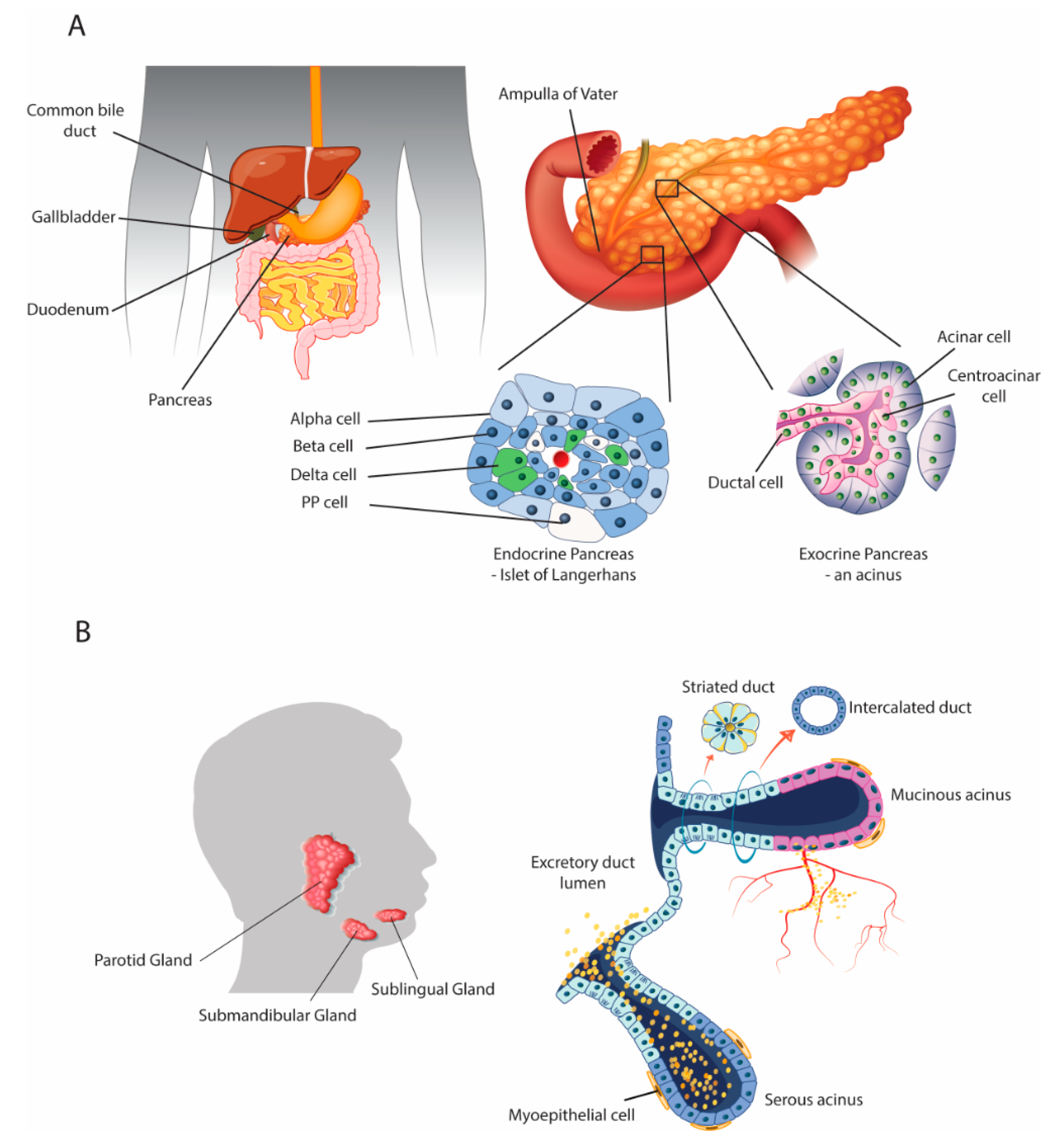



Biomedicines Free Full Text Defining Parallels Between The Salivary Glands And Pancreas To Better Understand Pancreatic Carcinogenesis Html




Metabolism Hormones Nutrition Life Style And Disease Prevention The Exocrine Pancreas And Food Digestion Pancreatic Enzymes Are Essential For Breaking Down Starches Fat And Protein The Pancreas Does Not Make Its Enzymes
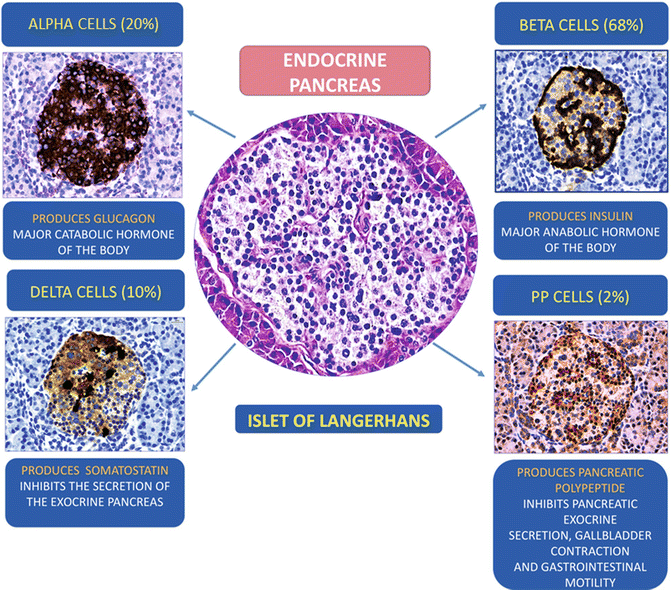



Physiology Of The Pancreas Radiology Key



0 件のコメント:
コメントを投稿